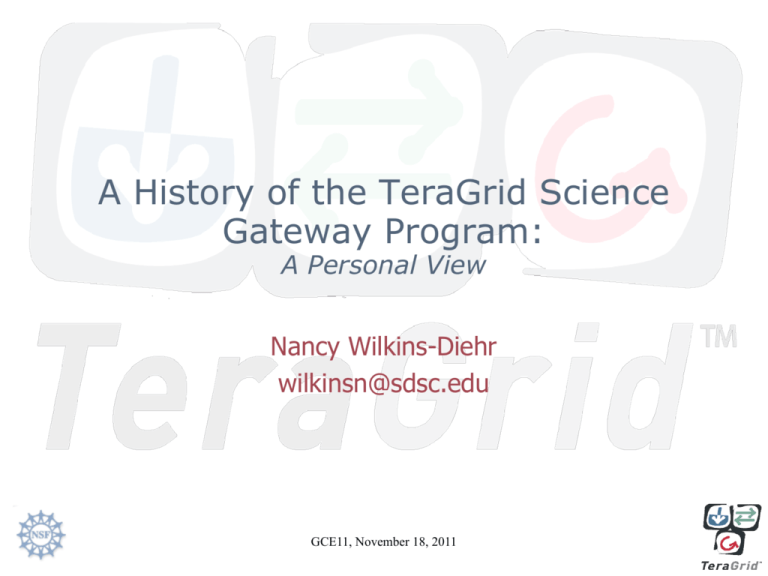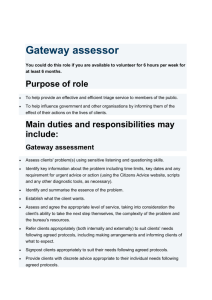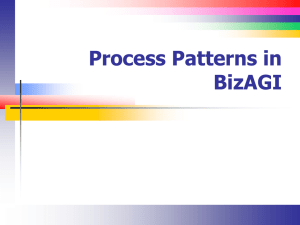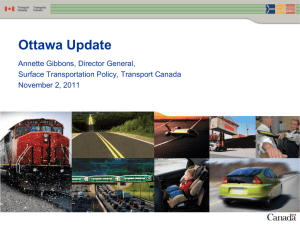KeynoteSlides
advertisement

A History of the TeraGrid Science Gateway Program: A Personal View Nancy Wilkins-Diehr wilkinsn@sdsc.edu GCE11, November 18, 2011 Gateway Development Timeline 1980s 1990s 2000s 2010s •BLAST server sends results by email •Still a working portal today •Supercomputer centers program begins •Mosaic released •10M web users (1993) •Static HTML, CGI, Perl, Python, Java, Flash •“PDB enhanced by Web browser” •NSF ITR program begins •Gateway program begins (2003) •10 prototypes •100,000 CPU hours used •Web 2.0 •User-generated content •HTML5 •Programmatic exchange between web pages •22 TeraGrid gateways •40M CPU hours used •40% of TG users come through gateways •1.8B web users GCE11, November 18, 2011 First ITR projects natural fit for fledgling gateway program •Linked •Linked Environments Environments for for Atmospheric Atmospheric Discovery Discovery •5 year deliverables for (LEAD) (LEAD) (Droegemeier, (Droegemeier, U Oklahoma) these 10 projects •National •National Virtual Virtual Observatory Observatory (NVO) (NVO) (Szalay, (Szalay, JHU) •Network •Network for for Computational Computational Nanotechnology Nanotechnology •Pros (Lundstrom, (Lundstrom, Purdue) Purdue) –Practical, focused •National •National Microbial Microbial Pathogen Pathogen Data Data Resource Resource (Stevens, U U Chicago/ANL) Chicago/ANL) development of needed(Stevens, •Building Biomedical Biomedical Communities Communities (Reed, (Reed, UNC) UNC) services in an unknown•Building •Neutron •Neutron Science Science Instrument Instrument Gateway Gateway (Cobb, (Cobb, arena ORNL) ORNL) •Cons •Grid •Grid Analysis Analysis Environment Environment (Newman, (Newman, Caltech) Caltech) •Emergency •Emergency Decision Decision Support Support (Eubanks, (Eubanks, LANL) LANL) –Limits flexibility once •Real-Time •Real-Time Urban Flood Hazard Analysis System infrastructure is developed (Urban, (Urban, UU Texas) Texas) •Open Science Grid Grid (Pordes, (Pordes, FNAL) FNAL) –2 years into the project•Open we Science were ready for allocated users GCE11, November 18, 2011 Next step, RATS of course •Requirements Analysis Teams –TeraGrid terminology for short-term teams formed to explore problems that spanned “working groups” –Gateway RAT was the first of these •Thanks Sebastien Goasguen –Extensive interviews with 10 initial projects over 2 months GCE11, November 18, 2011 RAT summary •Community allocations •Group accounts / limited privileges •Need for portal accounting capabilities, but little development •On-demand scheduling •Classifications (3 types) – Portals, desktop apps, access point to other grids •User model (3 modes) – Standard, portal, community GCE11, November 18, 2011 Actions for wg’s •tg-acctmgmt – Support for accounts with differing capabilities – Ability to associate compute job to a individual portal user – Scheme for portal registration and usage tracking –Support for OSG’s Grid User Management System (GUMS) – Dynamic accounts? GCE11, November 18, 2011 •Current reflections – Community account model working well once we developed a system – When developing policies, need to maintain momentum and document what’s been agreed to – Didn’t do enough to facilitate use of OSG – Dynamic accounts were an interesting idea (Globus incubator) that didn’t pan out Actions for wg’s •security-wg – Define open port ranges –Firewalls – Community account privileges – Need to identify human responsible for a job for incident response – Acceptance of other grid certificates – TG-hosted web servers, cgi-bin code GCE11, November 18, 2011 •Current reflections – Community account request form – Security page for monitoring community accounts – Moved away review of individual cgi-bin code, gateway code – Provided tips on risk and vulnerability, how to set up a secure gateway – Talked about shutting off jobs from individual users, tools never developed – More general cert acceptance policies developed Actions for wg’s (2) •Web Services (currently no wg for this) – Needs further study – Some Gateways (LEAD, NMBR) have immediate needs – Many will build on capabilities offered by GT4, but interoperability could be an issue – Web Service security – Interfaces to scheduling and account management are common requirements GCE11, November 18, 2011 •Current reflections – Web service standards in flux at the time, being defined by Microsoft, IBM, Sun, HP, Oracle, W3C, Oasis and the then-named Global Grid Forum (now Open Grid Forum) – 5 of 9 initial gateways interviewed expressed a need for web service interfaces – Push to move to Globus 4, with its WSRF interfaces, but no real developer uptake – Because of the lack of demand, TeraGrid never did develop widely used web interfaces to standard tasks like job submission and account management. Actions for wg’s (2) •software-wg – Interoperability of CTSS and VDT for OSG – Software installations across all TG sites – Community software areas •portals-wg –Variety of approaches needs further analysis •OGCE, in-VIGO, Clarens, Neutron Science Tomcat+Apache – TG User Portal GCE11, November 18, 2011 •Current reflections – Some requests foreshadowed the need for the Quarry virtual machine capabilities offered years later. – Resisted requests to overburden CTSS with individual software – Wanted TG to deliver simple solution that met the needs of many – Felt we had to evaluate every front-end portal approach, but really we did not – Could have done more to accommodate gateways with large data holdings Gateways Primer Outline Basis for later documentation, thanks Anurag Shankar •1. Introduction •2. Science Gateway in Context – a. Science Gateway (SGW) Definition(s) – b. Science Gateway user modes – c. Distinction between SGW and other TeraGrid user modes •5. Responsibilities and Requirements for Science Gateways – a. Interaction with and compatibility with TeraGrid communities – b. Control procedures • i. Community user identification and tracking (map TeraGrid usage to Portal user) • ii. Use monitoring and reporting • iii. Security and trust • iv. Appropriate use •3. Components of a Science Gateway – – – – a. User Model b. Gateway targeted community c. Gateway Services d. Integration with TeraGrid external resources (data collections, services, …) – e. Organizational and administrative structure •4. TeraGrid services and policies available for Science Gateways – – – – – – – – – a. Portal middleware tools (user portal and other portal tools) b. Account Management (user models, community accounts, ) c. Security environment (security models) d. Web Services e. Scheduling services (and meta-scheduling) f. Community accounts and allocations g. Community Software Areas h. All traditional TeraGrid services and resources i. Ability to propose additional services and how that would interact with TeraGrid operations GCE11, November 18, 2011 •6. How to get started – a. Existing resources – – – – • • • • i. Publication references ii. Web areas with more details iii. Online tutorials iv. Upcoming presentations and tutorials b. Who to contact for initial discussions c. How to propose a new Gateway d. How to integrate with TeraGrid Gateways efforts. e. How to obtain a resource allocation 2 years in, we’re ready for production •Production-quality infrastructure and services •Ready to support allocated users •Front-end development funded and performed by science communities – TeraGrid staff provide back-end integration and TG-specific support •Help desk gateway expertise as well as longer term collaborations –But, we begin to see early examples of sustainability challenges •What about the initial 10 projects? – Many remained production gateways – Some did not pan out due to lack of source code access –Others did not pan out as originally envisioned, but led to other useful capabilities like SPRUCE – Still others foreshadowed the need for services like the Quarry gateway hosting service GCE11, November 18, 2011 7 years of gateway talks GCE11, November 18, 2011 How to build a gateway in a day GCE11, November 18, 2011 7 years of great staff – thank you!! GCE11, November 18, 2011 Worldwide gateway activities GCE11, November 18, 2011 7 years of gateways GCE11, November 18, 2011 Gateway Program Infrastructure Highlights •Quarry •Helpdesk •Contributions to stable grid environment •Attribute-based authentication •Career development •Experience as incubator project with Apache GCE11, November 18, 2011 Gateway Program Lessons Learned •Start with a focused set of customers – Develops strong foundation for the program – But be ready for evolution • In our case this evolution was an expanded mission to help other projects once we had a working infrastructure • This was a turning point in the program, focus on backend integration added clarity • Documentation, tutorials, prebuilt VMs so others can help themselves – Diversity of domains provided a unique opportunity for developers to interact • Used project telecons to bring in interesting, relevant speakers •Don’t be distracted by requirements where there is a very small user base – Sometimes difficult to identify these a priori •Document achievements so issues are not revisited •Do few things, but do them well – Takes a lot of momentum to create change, especially in a distributed environment • Sometimes if you try to do too much, nothing will get achieved •Exemplar projects show others that this can actually work for them too GCE11, November 18, 2011 What makes a successful gateway: lessons learned •Close contact with user community – Many times hiding the fact that HPC is used is the best route •Meet a defined need – If you are the only one who provides a good service that is in high demand, users will put up with a lesser quality interface •But seeking to improve the UI isn’t a bad idea either •Reliability – Simplicity, easy to maintain •Dynamic leader who is almost entrepreneurial – Must constantly look for ways to improve the product, meet user needs, attract funding GCE11, November 18, 2011 Future Work •Continue to make the high end accessible in XSEDE – Keep barrier to entry as low as possible for gateways •Make cloud computing resources available to gateways – Immediately available resources could nicely fit the gateway usage model •Gateway development environment –Research vs infrastructure – Development vs operations – Rewards and recognition in an academic environment •Sustainability –Many good projects come and go – Researchers will not trust gateways for their science if they are not persistent – How to identify the good gateways so they can be funded sustainably GCE11, November 18, 2011 How can gateways be even more successful? •Need to be persistent in order to build •How to fund projects that are really making an impact for the long term? •Tensions include – Research vs infrastructure – Development vs operations – Academic reward systems •But, things are changing GCE11, November 18, 2011 Now for a look at real future work Terrific program in store today •Security •Apache efforts •Gateway building approaches •Several domain gateways GCE11, November 18, 2011






